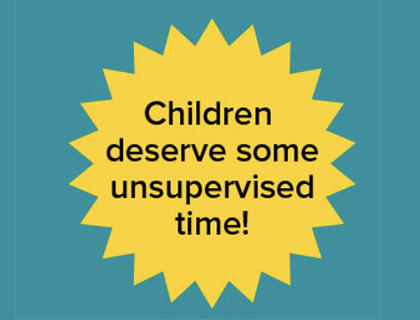Dear Free-Range Kids: I thought you might find this editorial refreshing. Arapahoe High is only about a mile from my house and although our young children would attend a different school (we’re in a different county) these types of events do cause you to take pause since them seem so random and violent. I was glad to see an article asking folks to maintain perspective. It can be hard, but wouldn’t we rather spend our time focusing on the positive we could achieve by preventing 140 deaths a year from swimming pool drownings than trying to turn our schools into fortresses not conducive to learning?
…”We can’t let our schools become fortified castles or military installations,” Gov. John Hickenlooper told Colorado Public Radio the other day. “It’s a place for learning and for ideas and for children.” Hickenlooper recognizes that schools, by and large, are already comparatively safe places. “If you look at the number of kids who die in accidental deaths in swimming pools, [it is] far more than die in shootings,” Hickenlooper said. “But somehow the shootings are so visceral and affect us … so deeply.”…
Lenore here: Amen, Governor! And of course, this is not a piece about the dangers of pools, but on the way we focus on certain, highly dramatic dangers, even when they are rarer than rare.




11 Comments
“During the 2007-08 school year, there was approximately one homicide or suicide of a school-age youth at school per 2.1 million students enrolled.”
I have personal experience losing loved ones to both homicide and suicide, and I’ve put plenty of time into understanding suicide and doing my own person-to-person advocacy on prevention.
As vital as prevention is, it’s even more important to me that we don’t ride a slippery slope to irrational, violence-is-everywhere responses.
First…I want to point out that I absolutely agree that our schools should not be fortresses and the security measures in place at most high schools (my son’s included) are over the top ridiculous and would not prevent a random shooting.
But to compare high school shootings to young children drowning makes no sense.
I live in Scottsdale and my metro area is one of the worst for drowning of young children. MOST (not all) of these are 100% preventable. MOST (not all) are the result of stupidity and neglect. School shootings are none of these things.
Maybe the reason we fear the shootings is that we HAVE no way to prevent them. With drowning, we have most of the control in our hands. It’s the randomness that scares us.
I can see where the Governor is coming from, sure the deaths are not equatable but our reaction to these sorts of things are. Consider for example: that whenever a teen driver causes a serious accident that is preventable, say texting, we enact a law that curbs that behavior; when elderly drivers lose control over their vehicles we do not. The reasons are myriad, primary of course is that seniors vote, whereas teens do not.
On the surface these two items don’t equate, and in some senses they affect you deeply, such as if you knew anyone who was harmed by either of these. Underneath it all is the feeling that we might want to do something about it. So we enact laws, through politicians who must make a connection or impact to us and through that we get some sort of theater that makes most people feel safe and secure. Remember, here we are basically preaching to the choir of people who understand that children are not always in harms way, but we are also a minority in many countries so in general politicians go the way the winds blow. When they begin blowing in our direction then maybe we won’t see so much overreaction.
Until “Think of the Children!” becomes a time of reflection on happy memories instead of a rallying cry of overreach we will probably see more theater than anything else.
I agree with Gina to some extent that it is the randomness. But it is more than the randomness (car accidents and fires are random, but they don’t go big like shootings) I think it is as Lenore says “highly dramatic dangers.” I think everyone reacts to the amount of trauma/drama on display in any tragic story.
With a child drowning, a car accident, a poisoning, etc there is trauma to display but the trauma is discreet, the circle of victimization is small. A grieving family (who probably don’t want to talk to the media), some friends. By the time the media catches wind of it, it is over and there isn’t much uncertainty left. And ultimately it is a short story with a fairly clear eyed answer as to what when wrong. Few to no other lives put in danger. Little uncertainty. If media comes into play at it is usually not until the basic facts are known.
With a shooting though everything is more raw and the circle of victimization is enormous. There is everyone who was in the area when it happened who fled for their lives. People who didn’t just witness death, but were threatened with it. There are all the people who frequented the area but by luck were not there at that moment. There are all the people who knew people who fled or knew people who frequent that area. It is a circle of pain so vast media becomes necessary, and yet makes everyone closer to the pain. There is the wait for it to be over, followed by the extended just not knowing who lived and who died. With an environment like a school where people are certain of who is impacted and have many social connections of varying closeness between those at the location and their families, the drama is magnified. This not knowing is for an easily identifiable group of people. And that group has lots of dramatic trauma on display as they go through a tormented head count. Like a room full of cancer patients everyone knows the news is bad the only question is which have it the worst. And all through it the media is gorging on the trauma of this sea of victims. It isn’t surprising that the TV audiences react with horror to the news man pulling people at near random from the street and each having a story to tell, while a chaotic sea of victims or apparent victims backdrops the interview. Then there is the search for answers…a why… that will never be so clear as “Child proof cap on the medicine was broken.” In high drama situations there is just so much more for the media to exploit. And exploit it they do.
The Dutch Radio 2 news did some anti-fearmongering today: the country is safer than we think, according to [expert] crime is just reported more often and we know better what happens around us because news travels faster.
He’s right that schools shouldn’t be fortresses, and should be places of learning. He’s also about 100 year too late on the second count. The possibility should also be considered that such a thing as a school as a place of learning is an impossible goal, since learning requires engagement with the world around us and schools deny that by their nature.
Security expert Bruce Schneier on perceived risk vs actual risk:
https://www.schneier.com/blog/archives/2006/11/perceived_risk_2.html
Pools? Hell, CARS.
Oh, but no way do we want to embrace the idea that all the seat belts and airbags in the world still don’t mean that our car-centric way of life is the most grave hazard our children face!
Lenore, you wrote: “but wouldn’t we rather spend our time focusing on the positive we could achieve by preventing 140 deaths a year from swimming pool drownings than trying to turn our schools into fortresses not conducive to learning?”
I think that’s a false choice. Of course we shouldn’t turn our schools into “fortresses not conducive to learning” (although some days I feel that, thanks to NCLB and overtesting, many of them aren’t conducive to learning in any case, but that’s a whole different rant). But the fact that more children die in drownings than in school shootings does not mean we shouldn’t do anything to prevent school shootings! School fires are rare, too, but no one complains about having fire alarms and fire drills.
The big question is WHAT we can do to prevent school shootings. Turn schools into fortresses? Of course not, that’s hyperbole. Improve school security in some other way? Maybe; let’s take an honest look at the costs and benefits, at what works and what doesn’t. Code Red drills? Sadly, yes — the existence of a Code Red plan in Newtown did save children’s lives. Stronger regulations on guns and ammunition? I think so, others disagree. Better mental health care? Absolutely. And maybe there are other steps that schools can take that we haven’t thought of yet. Instead of dismissing the problem as “rare” — which it seems to me you’re on the edge of doing here — let’s talk, honestly and creatively, about what we can do so that no parent ever again has to wait behind a police line at their child’s school to find out if their child is alive or dead.
Thank you, Lenore, as always, for keeping this blog open as a place where we can have these discussions!
@Anonymous this time: “Pools? Hell, CARS. Oh, but no way do we want to embrace the idea that all the seat belts and airbags in the world still don’t mean that our car-centric way of life is the most grave hazard our children face!”
Yes, indeed. And if just every single person would behave perfectly 100% of the time, following every traffic rule down to the last dot, all those horrible accidents wouldn’t happen in the first place!
Never mind the fact we’re talking about humans…
One problem is that decision makers and government officials seldom take a pragmatic approach. We don’t necessarily look for things that work and seldom set up any method to measure if it is working. One of my practice areas is firearms laws. I have done a lot of research into gun control and the majority of studies tend to show no real increase in safety or lowering of crime that can be attributed to stricter regulations of guns and ammunition. Despite this, there are still frequent calls to enact these laws.
I am not going to suggest that there be no regulation, but I do tend to view these kinds of proposals with skepticism. As for improving access and funding to mental health services, there is evidence that this decreases some criminal offenses and helps lower substance abuse rates. Despite this, many states haven’t really done much to help in this area.